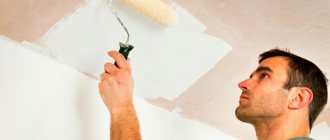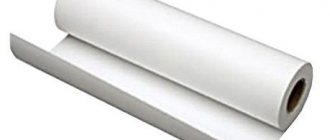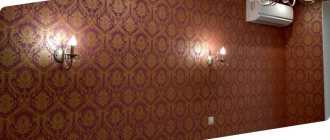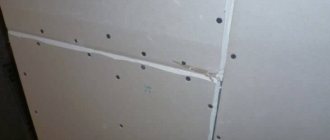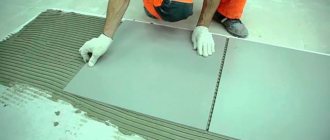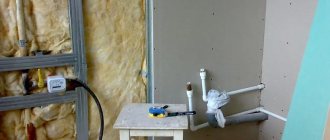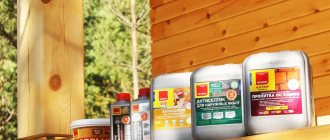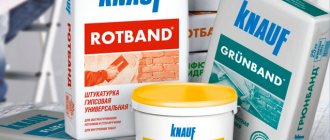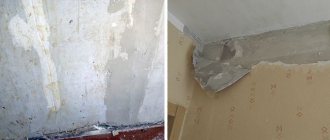In order to properly glue glass wallpaper for painting, you must strictly adhere to the technology. When gluing glass wallpaper, you need to know that they have a front and a back side, which should never be confused. This wallpaper is rolled up with the front side facing inward.
When gluing glass wallpaper, you must choose a special glue that is intended for heavy wallpaper. It can be produced both in ready-made liquid form and in powder form. When wallpapering, the glue must be applied not to the wallpaper, but to the walls. To do this you need to use a roller.
Before gluing the glass wallpaper, it is necessary to take measurements and cut the corresponding strips with scissors. In this case, the master should wear long sleeves and gloves, since fiberglass can crumble and cause damage to his health.
Before gluing glass wallpaper, it is necessary to prime the walls. The seams of this wallpaper must be joined carefully, but tightly enough. This will allow you to get a uniform texture of the surface being glued.
Fiberglass wallpaper can be glued to any surface, which will add originality and unsurpassed beauty to any room.
General information
I must say that this material is not so new. In the West, glass wallpaper became widespread in the early 60s of the last century. But they appeared on the domestic market much later, and at first they were used only for office decoration, and only after some time they began to “migrate” to apartments.
This coating is made from fiberglass obtained from special glass briquettes, which are drawn into threads during the heating process.
A woven fabric is made from these threads, after which it is impregnated with a special solution, the composition of which is kept secret by the manufacturers. As a result, the material acquires a stable shape and some other qualities.
Fiberglass wallpaper without painting of different textures
It should be noted that this coating is absolutely environmentally friendly. The only disadvantage is that the wallpaper comes in only one color, but can have different textures.
After covering the walls with glass wallpaper, the moment comes to cover them with paint or apply a design to the walls. Therefore, this material is also called paintable wallpaper.
Advantages and disadvantages
Fiberglass is a unique material that has a lot of advantages:
- Environmental friendliness . The canvases contain exclusively natural materials.
- Durability . Glass wallpaper is resistant to mechanical and chemical cleaning.
- Durability . The service life of the material is at least 30 years. During operation they can be repainted up to 20 times.
- Fire safety . The material does not support combustion and does not emit harmful substances when heated.
- Easy to care for . Fiberglass wallpapers do not retain dust and are easy to clean.
- Resistance to microorganisms . The material does not contain a breeding ground for any kind of parasites: mold, insects, fungi.
- Moisture resistance . Fiberglass wallpaper can be glued even in the bathroom, since it does not absorb water at all.
According to professional plasterers, glass wallpaper has another great advantage. They are able to act as a reinforcing mesh and perfectly keep the putty layer from cracking when the building shrinks.
Expert opinion
Kukushkin Anatoly Sergeevich
Repair specialist
The disadvantages of glass wallpaper include its high cost and the need for gluing onto perfectly flat walls. Sometimes the disadvantages include the difficulty of removing from the walls. Dismantling glass wallpaper is a labor-intensive process, because they are attached to the surface almost “tightly”.
Paint selection
It must be said that the process of painting glass wallpaper with your own hands is no different from applying paint to other surfaces. However, the peculiarities lie in the choice of the dye itself.
According to experts, the best option for glass wallpaper is water-dispersed compositions, the binding element of which is acrylic resins.
They are good because they do not hide the texture of the wallpaper, and also retain all the properties of glass fiber, including:
- Resistance to open fire;
- Environmental friendliness;
- Vapor permeability;
- Moisture resistance, etc.
Advice! To provide maximum passive fire protection in your home, you can coat the wallpaper with fire-resistant acrylic paint. In addition, it is advisable to treat metal communications with a fire retardant compound. Fire-retardant metal paints Polistil or other similar coatings are suitable for these purposes.
Water-dispersion paints themselves have the following advantages:
- They are odorless because water is used as a solvent.
- Possibility of application by any known method.
- Dries quickly.
- Possibility of obtaining any shade using tinting.
- Affordable price.
Advice! When choosing paint, you need to make sure that it is washable, which will greatly simplify cleaning the coating. Information about the paint is contained in the instructions on the packaging.
Colors for acrylic paint
As for the selection of paint colors, it all depends on the individual preferences of the owners and the interior of the room. The only thing is that experts do not recommend covering walls with too bright colors.
However, individual eye-catching inserts are quite acceptable; in addition, designs can be applied using stencils. For example, small images on the walls will visually enlarge a small room.
Painting
Preparing the base
The first thing that interests home craftsmen who are faced with this procedure is whether it is necessary to prime glass wallpaper before painting? We can definitely say that this operation is necessary, however, it is performed not with an ordinary primer, but with glue diluted with water, which was used to decorate the walls.
Such priming will improve the adhesion of the paint to the coating and also reduce its consumption. If the wallpaper has been standing for some time without painting, then before applying the primer, you should wipe it from dust.
In the photo - applying paint to glass wallpaper
Painting
After the glue has dried, you should cover the wallpaper with water-based paint. To do this, you can use a roller, brush or spray. Most often, painting is done with a roller.
So the work looks like this:
- First of all, you need to prepare the paint - stir it well so that the composition is homogeneous, and then add the required amount of color. If you do not know the required proportion of color and paint, then you can first mix a small amount of the composition, gradually adding dye to it until the desired shade is obtained. Once the proportions are determined, you need to paint the entire contents of the paint bucket.
- Then the coloring composition is poured into a special tray into which the roller is dipped. To distribute the paint evenly, it must be squeezed onto a raised area in the pallet.
- After this, the paint is applied to the walls from the ceiling to the floor. The coating should be applied in a thin, even layer.
- The joints between the wallpaper can be painted with a brush.
- If necessary, paint should be applied to the wallpaper again, provided that the previous layer has dried.
FAQ
Is it possible to glue glass wallpaper on a glazed loggia?
Yes, glass wallpaper can be installed in any room.
How resistant are glass wallpapers to cat claws?
Fiberglass wallpaper is not a vandal-proof coating and cannot resist cat claws without additional protection.
Is it possible to glue glass wallpaper in a children's room?
If a child has a tendency to allergies, you should not put glass wallpaper in his room.
After drying and painting, seams appeared on the wall covered with glass wallpaper. Can it be fixed?
Unravel the edges 5-10 cm, coat with border or other strong adhesive and smooth with a wallpaper spatula with force towards the seam. But this way you will remove a gap of no more than 1-2 mm. To prevent the seams from coming apart, the glass wallpaper should not be pulled too tightly during gluing.
How to remove glass wallpaper from drywall?
The fiberglass wallpaper is imprinted so firmly into the surface of the drywall that it is almost impossible to remove it without damaging the base. It is more advisable to coat the wall with primer and putty to remove the relief, and stick new wallpaper on top of the old coating.
How can you wash glass wallpaper when it gets dirty?
Fiberglass wallpaper is resistant to water and chemicals, so it can be washed even with a brush. But the question is: will the paint with which they are coated hold up? Here it is worth looking at the paint packaging and studying the recommendations of its manufacturer.
Conclusion
Coating glass wallpaper with paint is a fairly simple and quick procedure. The most important thing is to choose a suitable composition that will not change the properties of the finishing material. Otherwise, you just need to stick to technology.
For more information on this topic, watch the video in this article.
For design purposes, it is best to choose glass wallpaper as a finishing material. They not only have excellent external properties, but can also be easily painted, maintaining their texture.
How to glue glass wallpaper for painting?
In order to properly glue glass wallpaper for painting, you must strictly adhere to the technology. When gluing glass wallpaper, you need to know that they have a front and a back side, which should never be confused. This wallpaper is rolled up with the front side facing inward.
When gluing glass wallpaper, you must choose a special glue that is intended for heavy wallpaper. It can be produced both in ready-made liquid form and in powder form. When wallpapering, the glue must be applied not to the wallpaper, but to the walls. To do this you need to use a roller.
Before gluing the glass wallpaper, it is necessary to take measurements and cut the corresponding strips with scissors. In this case, the master should wear long sleeves and gloves, since fiberglass can crumble and cause damage to his health.
Before gluing glass wallpaper, it is necessary to prime the walls. The seams of this wallpaper must be joined carefully, but tightly enough. This will allow you to get a uniform texture of the surface being glued.
Fiberglass wallpaper can be glued to any surface, which will add originality and unsurpassed beauty to any room.
Glue preparation
Speaking about glue for glass wallpaper, first of all it must be said that it is strictly forbidden to use glue for ordinary paper wallpaper. The fact is that the textured surface of glass wallpaper impregnated with glue weighs significantly more than its paper counterpart, so the adhesive force of the “paper” glue to hold the wallpaper on the wall, and even more so on the ceiling, will clearly not be enough. Therefore, it is recommended to use only special adhesives. Most manufacturers of glass wallpaper are also manufacturers of glue for them, so the best option would be to purchase wallpaper and glue of the same brand. If this is not possible, we recommend buying glue from well-known manufacturers, paying special attention to adhesives with colored pigments, since with them it is easiest to achieve complete and uniform coverage of the entire canvas.
It is better to give preference to trusted glue manufacturers
Please note that for gluing some types of glass wallpaper, glue is not needed at all - they are already coated with an adhesive composition, which just needs to be soaked with water before gluing.
In most cases, glue for glass wallpaper is simply diluted with water, making sure that the powder dissolves well without leaving any lumps behind. In some cases, the glue needs to sit for several hours before use. More information about the preparation of each specific glue can be found in the instructions supplied with it.
Painting glass wallpaper
Painting glass wallpaper is a fairly simple procedure that can be performed even by an inexperienced craftsman. Initially, you need to choose paint for glass wallpaper. The ideal option for this would be water-based paint.
Before you start applying paint, it is necessary to prime the glass wallpaper, due to which the effect of paint adhesion will significantly increase. The paint must be applied with a roller. This will allow it to be distributed as evenly as possible over the surface of the glass wallpaper.
Paint is applied to the glass wallpaper in several layers. Between applying layers, it is imperative to maintain a pause of 10-12 hours. Painting glass wallpaper can be done using borders, stencils, and azure, which will significantly improve the design of any room.
An original option is squeegee painting of glass wallpaper. This technique is characterized by simplicity and a high level of efficiency. It is best to use bright colors as the main tone of paint. After the base layer has dried, it is necessary to apply a glaze coating with a roller.
How to prime glass wallpaper before painting?
The question of priming glass wallpaper before painting interests many specialists. It is necessary to use a primer, as it can significantly improve the effect of painting. With its help, you can make the texture of glass wallpaper much brighter and better quality.
The choice of primer can be varied. On the modern construction market there are many primers that are designed for glass wallpaper. The choice of such a primer directly depends on the desires and requirements of the master.
If you have glue left over when gluing glass wallpaper, it can also be used as a primer. This option will be quite economical. The quality of this primer is very good and you will not have to spend money on purchasing it.
- Useful material about which wallpaper is best for painting.
- How to paint wallpaper for painting - see expert advice here https://glavspec.ru/kak-krasit-oboi-pod-pokrasku.html
- Materials for wall insulation - see useful information here.
Fiberglass wallpaper in all its glory
Fiberglass wallpaper is a practical and original type of rolled wall covering. This coating is made from glass fibers, from which the fabrics are woven. The way in which the fabric was woven affects the formation of a particular pattern on the surface of the wallpaper. The starting components of fiberglass are quartz sand, clay, soda and limestone. All of these are natural and therefore environmentally friendly substances, which will please many caring parents.
Fiberglass wallpaper not only has an environmentally friendly composition, but also a number of advantages:
- The main advantage of glass wallpaper: they do not support combustion, do not emit toxic substances and are a deterrent to the spread of fire. This is possible thanks to their unique composition, which includes non-flammable components. This feature allows this material to be used even when finishing escape routes in case of fire.
- Fiberglass is a very durable material that can even be found in aircraft construction. This news will please pet owners. Claws and beaks cannot break through here, since the canvas can withstand tensile loads of up to three tons per 1 m2.
- Fiberglass wallpaper is very practical to use. Their service life is more than 30 years, and during this time they can be repainted up to 20 times, subjected to mechanical and chemical cleaning. They will also protect walls from the appearance of microcracks and other defects.
- Fiberglass does not accumulate static electricity, which means it does not attract or collect dust.
- The fabric structure of the wallpaper allows air and moisture to pass freely, thereby not creating conditions for the formation of mold and mildew.
- A wide range of textured designs is designed to satisfy the most capricious consumers.
This miracle material also has disadvantages. An undeniable disadvantage is the rather high cost, and since glass wallpaper must be painted, the amount of costs also increases by the price of paint materials.
If the advantages still outweigh the disadvantages, then when choosing wallpaper you need to keep in mind that they come in two main types: regular and jacquard. The usual ones have a simple type of weaving in the “rhombus”, “Christmas tree” format, etc. Jacquards have a complex and often asymmetrical pattern such as “bamboo” or “stained glass”. Glass wallpaper, regardless of type, is sold in rolls (the world standard is 1 m wide, 12.5 m, 25 m, 50 m long) with end caps that protect the edges from damage.
What it is?
Glass wallpaper is a finishing material for walls and ceilings. This is a fabric woven from elongated threads of molten glass, consisting of quartz, limestone, starch, and soda. To give strength, the resulting fabric is impregnated with glue and modified starch. This combination of components and technologies allows you to create 100% environmentally friendly, highly durable wallpaper.
By interweaving thin and thick glass threads on canvas, various designs are created. They are not as varied as on other types of wallpaper, and are very weakly expressed. The most common pattern is matting. This pattern got its name because of its resemblance to ancient homespun cloth. You can also find diamond, checkerboard, and herringbone patterns on sale.
Glass wallpaper is supplied to the consumer in rolls 1 m wide and 12.5 to 50 m long. The cost of the material depends on the complexity of the pattern, manufacturer, and roll length.
Based on density, glass wallpaper is divided into 3 types:
- The first grade is high-density canvas, the rolls are protected on the sides with plugs.
- The second grade is less dense and high-quality wallpaper. Packed in polyethylene.
- Non-standard - the quality of the canvases is very low, there are defects: threads stick out, the design is knocked down in places.
When choosing wallpaper, pay attention to its density. If the material is intended for wall decoration, then this figure should be from 100 g/sq. m.
How are they different from fiberglass?
Fiberglass wall coverings have recently appeared on the domestic market. It is not surprising that many consumers believe that glass wallpaper and fiberglass are the same thing.
In fact, these materials have significant differences:
- Preparation method . Fiberglass is a woven material produced on machines. Fiberglass is made by pressing fiberglass threads and has a texture similar to paper.
- The presence of a relief or pattern . Fiberglass is a perfectly smooth surface that can be repainted an unlimited number of times. It is recommended to repaint glass wallpaper no more than 25 times to avoid losing the pattern.
- Price . Fiberglass costs at least two times less than glass wallpaper.
- Features of finishing . Fiberglass wallpaper does not require any additional processing before painting. It is recommended that fiberglass be primed.
- Density _ For glass wallpaper it is several times higher than for fiberglass. This is a lightweight material, which builders really appreciate when it comes to covering the ceiling.
How to glue glass wallpaper for painting: a step-by-step process
Fiberglass wallpaper is a surface that requires further painting, but first you need to cover the room with it. Familiarizing yourself with how to glue glass wallpaper for painting will not take much time. The technology is simple, especially if you already have experience working with conventional wallpaper. The process consists of the following steps:
- It is better to carry out pasting in a room with a temperature of 18 to 25 ° C and a relative air humidity not exceeding 70%. This recommendation is due to the need for the glue to dry evenly. To prevent air bubbles from forming under the canvas, you need to protect it from direct sunlight and drafts.
- Glue for fiberglass wallpaper must be selected specially designed specifically for this type of material. You can buy glue in dry and ready-made form. The product label of the glue indicates the area for which a given volume of packaging is designed. To glue fiberglass wallpaper, you cannot use PVA glue or other adhesives that contain PVA. Otherwise, the appearance of yellow spots and stains on the surface cannot be avoided.
- Preparing the wall surface. Under glass wallpaper you will need a wall/ceiling cleared of old coatings. The surface must be smooth, so it is necessary to putty and sand all uneven areas. Then, using an acrylic primer for interior work, carefully prime all surfaces. After complete drying, you can begin directly gluing the glass wallpaper.
- If, when choosing glass wallpaper, preference was given to a canvas with a simple pattern, then the gluing process will be as follows: it is necessary to cut the canvas corresponding to the height of the room wall, with an allowance of 10 cm to adjust the pattern; Apply glue evenly to the surface to the width of one and a half canvases; glue the first canvas, it is better to do it plumb to get a vertical line; smooth the glass sheet using a plastic spatula. You need to smooth it from the center to the edges, without being zealous on the side where the joint with the next canvas will be; excess material at the top and bottom should be cut off with a sharp knife; glue the second sheet end-to-end to the first and then repeat all steps, not forgetting to smooth out the joints; The process of covering the ceiling with glass wallpaper with a simple pattern also takes place.
- If you like wallpaper with a jacquard type of pattern, then the steps for pasting the room will be as follows: the canvas should be cut taking into account the rapport. Rapport is the distance between repetitions of a pattern. You should also leave 10–12 cm for adjusting the canvas. The resulting pieces can be numbered on the reverse side; rapport is indicated on the product label. This indicator must be taken into account before calculating the required amount of wallpaper per room. You don’t have to make blanks, but just glue them and adjust them to the design, unwinding them from the roll; further steps are the same as when gluing glass wallpaper with a simple pattern.
- After the glue has completely dried, i.e. After no less than 24 hours, you can start painting the glass wallpaper.
Application technology
Priming the walls with glue before wallpapering consists of preparatory activities starting with the actual application.
H3 - Preparatory activities
At this stage, the base is prepared.
- removal of nails, dowels, brackets (if any);
- removing peeling putty, removing paint residues, dirt, dust, oil and other stains;
- puttying;
- wetting the walls with warm water to remove construction dust.
After drying, you can proceed to the next stage.
Preparation of the primer composition
How to prepare glue for use as a primer is usually indicated on the packaging; if such information is not available, then you should proceed in the sequence indicated below.
How to dilute glue and prime walls
For priming, the glue/water ratio should be reduced by one and a half times. For example, if the manufacturer indicated that a pack of glue should be diluted in 4 liters of water, then 6 liters should be taken to treat the surface.
The water should be heated to 35 - 40 o C, this is better for the glue to dissolve. In cold water the process will take longer.
The consistency of the primer composition should be liquid - a thick composition cannot be evenly distributed over the surface, the consumption will increase, the drying time will increase, which means you will have to wait a long time before directly gluing it.
Workflow Description
Before dilution, measure out the required amount of water and pour it into a container of suitable volume.
The glue is poured in gradually, continuously mixing the contents. After one portion is completely dissolved, add the next one.
